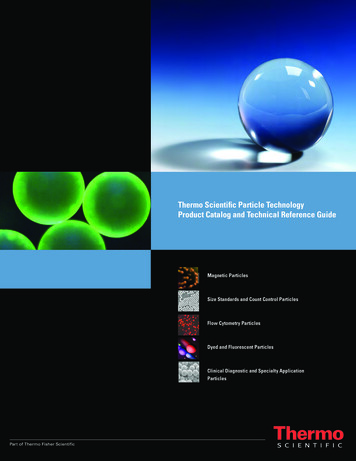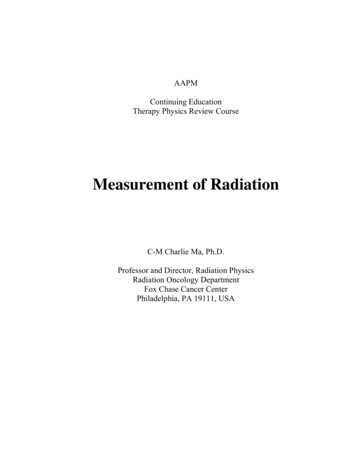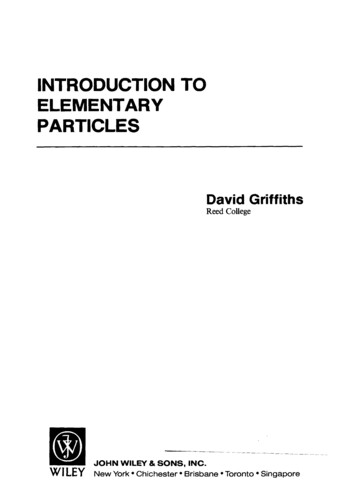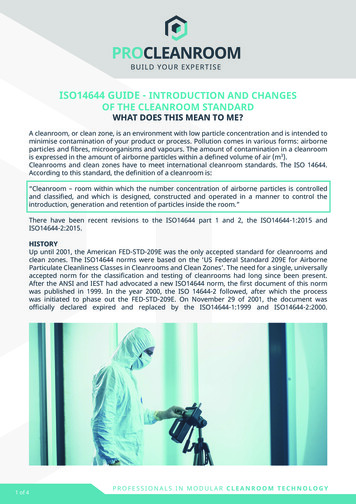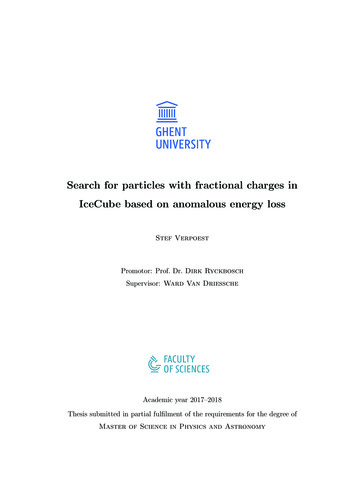
Transcription
Search for particles with fractional charges inIceCube based on anomalous energy lossStef VerpoestPromotor: Prof. Dr. Dirk RyckboschSupervisor: Ward Van DriesscheAcademic year 2017–2018Thesis submitted in partial fulfilment of the requirements for the degree ofMaster of Science in Physics and Astronomy
iiiAcknowledgementsBefore commencing the scientific part of this work, I want to thank the people whohave contributed in one way or another to letting it come into existence and to forgingit into its final form.My gratitude goes out to Prof. Dr. Dirk Ryckbosch for inciting my interest in particle physics through his lectures, for the trust and encouragement over the past yearand for giving me the opportunity to do an internship at WIPAC this past summer,where it became for the first time clear to me that doing a thesis in experimentalparticle physics was indeed the right choice for me.I also owe a big thank you to my supervisor Ward Van Driessche for showing methe ropes of working on IceCube. Ward, thank you for trusting me with this partof your analysis, for always being available to answer my questions, however simplethey may have been, and for your helpful advice in the writing of this thesis. It wasa pleasure to work with you during the past year.I would also like to thank the other master thesis students who worked at theINW and with whom I’ve become a lot closer throughout this year. Thank you forthe company at the lunch and ping-pong table, for the shared laughs and for generallymaking the daily work a more pleasant experience.To my other friends, both inside and outside physics: thank you for brighteningmy free time and providing me with the necessary relaxation outside of work.Last but not least I want to thank my family and particularly my parents forencouraging me to pursue my own interests and always supporting me in all possibleways along the journey that has ultimately led to the completion of this thesis.Stef Verpoest, June 2018
vSummaryThe Standard Model of particle physics currently constitutes our best description ofthe known fundamental matter particles and their interactions. For decades, it hassucceeded to describe experiments to within extreme precision and to make impressivepredictions such as the existence of the Brout-Englert-Higgs boson. We know howeverthat the Standard Model is not the full picture, as it does not describe gravity andseveral observations seem to hint at the existence of unknown physics like dark matter.A multitude of theories that are extensions to the Standard Model exist and try togive a more complete description of nature.An interesting property of the Standard Model is that all particles that can existas free particles have an electric charge that is a multiple of the so-called elementarycharge. Quarks have fractional charges, namely one-third or two-thirds of the elementary charge, but are always bound together by the strong interaction into systemsthat have a charge which is an integer multiple of the elementary charge. Some extensions of the Standard Model do on the other hand predict the existence of fractionallycharged particles which can exist freely.Multiple experiments have searched for this kind of particle but none of them resulted in successful detections. The IceCube Neutrino Observatory located at the geographical South Pole also provides the possibility to look for these fractional charges.IceCube detects particles inside a cubic kilometre of ice with about 5000 detectors sensitive to Cherenkov light radiated by highly energetic charged particles. The amountof emitted Cherenkov light is dependent on the charge of the particles, which allowsIceCube to distinguish fractional charges from the already known Standard Modelparticles.Not only Cherenkov light production but also the energy loss while moving throughthe ice is charge dependent. It is this quality which we try to use in this thesis todifferentiate fractionally charged particles from particles with an integer charge. Thisis done by applying reconstruction techniques which try to determine the energyloss of a particle throughout the detector as well as possible from the detected light.These reconstructions are epitomized into a number of variables which describe theirmost important characteristics and which show a clear difference between the signal(fractional charges) and the background (Standard Model particles).The goal of this thesis was to construct such variables and to test their potentialin a multivariate analysis based on boosted decision tree forests (BDTs), a machine
learning technique. The power of the variables which differentiate between signaland background is combined by the BDT into a score which represents how signal- orbackground-like a certain event is and which can therefore be used in the classificationof events.Multiple uncorrelated variables which clearly describe the anomalous energy lossof fractionally charged particles were found. The first BDT tests show good resultsconcerning the correct classification of signal and background, from which we canconclude that the method at hand has a lot of potential. Consequently, these variableswill be used in the overarching search for fractional charges in IceCube and will becombined with other, independently constructed variables with the aim of training astrong BDT.
viiSamenvattingHet Standaard Model van de deeltjesfysica vormt op dit moment de beste beschrijvingvan de gekende fundamentele deeltjes en hun interacties. Al decennia lang slaagt heterin experimenten met extreme precisie te verklaren en indrukwekkende voorspellingen te doen, zoals het bestaan van het Brout-Englert-Higgs boson. Toch weten wedat het Standaard Model niet het volledige plaatje is. Het omvat bijvoorbeeld geenverklaring voor zwaartekracht en meerdere observaties lijken te wijzen op het bestaanvan ongekende fysica zoals donkere materie. Er bestaan intussen een enorm aantaltheorieën die uitbreidingen zijn op het Standaard Model en die proberen een meercomplete beschrijving van de natuur te geven.Een interessant gegeven van het Standaard Model is dat alle deeltjes die vrijkunnen bestaan een elektrische lading hebben die een veelvoud is van de zogenaamdeelementaire lading. De quarks hebben fractionele ladingen, namelijk één derde oftwee derde van de elementaire lading, maar worden door de sterke interactie steedssamen gebonden tot combinaties die een elektrische lading hebben dat een geheelveelvoud is van de elementaire lading. In sommige mogelijke uitbreidingen op hetStandaard Model wordt echter wel het bestaan van deeltjes met fractionele lading alsvrije deeltjes voorspeld.Meerdere experimenten hebben reeds gezocht naar dergelijke deeltjes maar tot nogtoe zonder succes. Ook het IceCube Neutrino Observatory experiment op de Zuidpool biedt de mogelijkheid om te zoeken naar deze fractionele ladingen. IceCube detecteert deeltjes binnen een kubieke kilometer ijs aan de hand van een 5000-tal detectoren gevoelig voor Tsjerenkovstraling dat uitgezonden wordt door hoog-energetischegeladen deeltjes. De hoeveelheid uitgezonden Tsjerenkovstraling is afhankelijk vande lading van deeltjes, wat IceCube in staat stelt om de fractionele ladingen te onderscheiden van de reeds gekende deeltjes van het Standaard Model.Niet enkel Tsjerenkovstraling productie maar ook energieverlies bij het bewegendoorheen het ijs is ladingsafhankelijk. Het is deze eigenschap die we in deze thesisexpliciet proberen te gebruiken om fractioneel geladen deeltjes te onderscheiden vandeeltjes met een gehele lading. Dit doen we aan de hand van reconstructietechniekendie het energieverlies van een deeltje doorheen de detector zo goed mogelijk proberente bepalen aan de hand van het gedetecteerde licht. Deze reconstructies wordensamengevat tot enkele variabelen die de belangrijkste eigenschappen ervan beschrijvenen die een duidelijk onderscheid geven tussen het signaal (fractionele ladingen) en de
viiiSAMENVATTINGachtergrond (deeltjes uit het Standaard Model).Het doel van deze thesis was het construeren van dergelijke variabelen en het testenvan hun potentieel in een multivariate analyse aan de hand van boosted decision treeforests (BDTs), een machine learning techniek. De kracht van de variabelen die eenonderscheid vertonen tussen signaal en achtergrond wordt door de BDT gecombineerdtot een score die weergeeft hoe signaal- of achtergrondachtig een evenement is en duskan gebruikt worden voor de classificatie van evenementen.Meerdere ongecorreleerde variabelen die het anomale energieverlies van fractioneelgeladen deeltjes duidelijk weergeven werden gevonden. De eerste BDT tests tonengoede resultaten wat betreft de juiste classificatie van signaal en achtergrond, waaruitwe kunnen concluderen dat de gebruikte methode veel potentieel heeft. Bijgevolgzullen de gevonden variabelen gebruikt worden in de overkoepelende zoektocht naarfractionele ladingen in IceCube en gecombineerd worden met andere, onafhankelijkverkregen variabelen met als doel het trainen van een krachtige BDT.
vattingviiContentsixList of FiguresxiiiList of TablesxviiIntroductionxix1 The Standard Model of particle physics1.1 Overview of the Standard Model . . . .1.1.1 The gauge principle . . . . . . .1.1.2 Fundamental matter: fermions .1.1.3 Interactions and gauge bosons . .1.1.4 Brout-Englert-Higgs mechanism1.2 Beyond the Standard Model . . . . . . .11234682 Cosmic rays & neutrinos2.1 Primary cosmic rays . . . . . . . .2.1.1 Spectrum . . . . . . . . . .2.1.2 Composition . . . . . . . .2.2 Cosmic ray air showers . . . . . . .2.2.1 Hadronic component . . . .2.2.2 Muonic component . . . . .2.2.3 Electromagnetic component2.2.4 Neutrino component . . . .2.3 Neutrinos . . . . . . . . . . . . . .111111131415161717183 The3.13.23.3.IceCube Neutrino Observatory21Detection mechanism . . . . . . . . . . . . . . . . . . . . . . . . . . . . 21Digital Optical Modules . . . . . . . . . . . . . . . . . . . . . . . . . . 22Detector overview . . . . . . . . . . . . . . . . . . . . . . . . . . . . . 24
xCONTENTS3.43.53.3.1 IceCube In-Ice Array3.3.2 DeepCore . . . . . .3.3.3 IceTop . . . . . . . .3.3.4 IceCube Lab . . . .Data acquisition . . . . . .Signal topologies . . . . . .4 Fractional charges4.1 Introduction . . . . . . . . . .4.2 Theoretical motivation . . . .4.3 Detection mechanism . . . . .4.3.1 Cherenkov radiation .4.3.2 Secondary production4.3.3 Signal . . . . . . . . .4.4 Previous searches . . . . . . .4.4.1 CMS . . . . . . . . . .4.4.2 Mont Blanc LSD . . .4.4.3 Kamiokande II . . . .4.4.4 MACRO . . . . . . . .5 From simulation to analysis5.1 Simulation . . . . . . . . .5.1.1 Simulation chain .5.1.2 Weighting . . . . .5.1.3 Background . . . .5.1.4 Signal . . . . . . .5.2 Experimental data . . . .5.3 Preceding analysis . . . 343446 Reconstruction & analysis techniques6.1 Reconstruction techniques . . . . . . .6.1.1 Likelihood description . . . . .6.1.2 Line-Fit . . . . . . . . . . . . .6.1.3 SPE and MPE fit . . . . . . . .6.1.4 Millipede . . . . . . . . . . . .6.2 Boosted decision tree classifiers . . . .6.2.1 Introduction . . . . . . . . . .6.2.2 Decision trees . . . . . . . . . .6.2.3 Boosted decision tree classifiers6.2.4 Overtraining . . . . . . . . . .6.2.5 Pruning . . . . . . . . . . . . .474747474850535354565758.7 Millipede study597.1 Millipede fit . . . . . . . . . . . . . . . . . . . . . . . . . . . . . . . . . 597.2 Variables . . . . . . . . . . . . . . . . . . . . . . . . . . . . . . . . . . 607.2.1 Mean energy loss . . . . . . . . . . . . . . . . . . . . . . . . . . 62
CONTENTS7.37.47.57.2.2 Standard deviation . .7.2.3 Uniformity . . . . . .7.2.4 Track length . . . . .Variable Correlations . . . . .BDT results for charge 1/3 .7.4.1 Score distribution . .7.4.2 Overtraining check . .7.4.3 Variable importance .7.4.4 Additional BDT testsBDT results for charge 2/3 .xi.8 Conclusions & outlookA Additional plotsA.1 Contained variable distributions .A.2 Correlations plots . . . . . . . . .A.2.1 Uncontained variables . .A.2.2 Contained variables . . .6365666869707373747679.8383858687B Rejected variablesB.1 Excluding zero energy segments . .B.1.1 Variables . . . . . . . . . .B.1.2 BDT results . . . . . . . . .B.2 Track length variations . . . . . . .B.2.1 Variations of used variablesB.2.2 Other variables . . . . . . .89898992929295C Communication to the General PublicBibliography99101 p
ways along the journey that has ultimately led to the completion of this thesis. Stef Verpoest, June 2018. v Summary The Standard Model of particle physics currently constitutes our best description of the known fundamental matter particles and their interactions. For decades, it has succeeded to describe experiments to within extreme precision and to make impressive predictions such as the .
